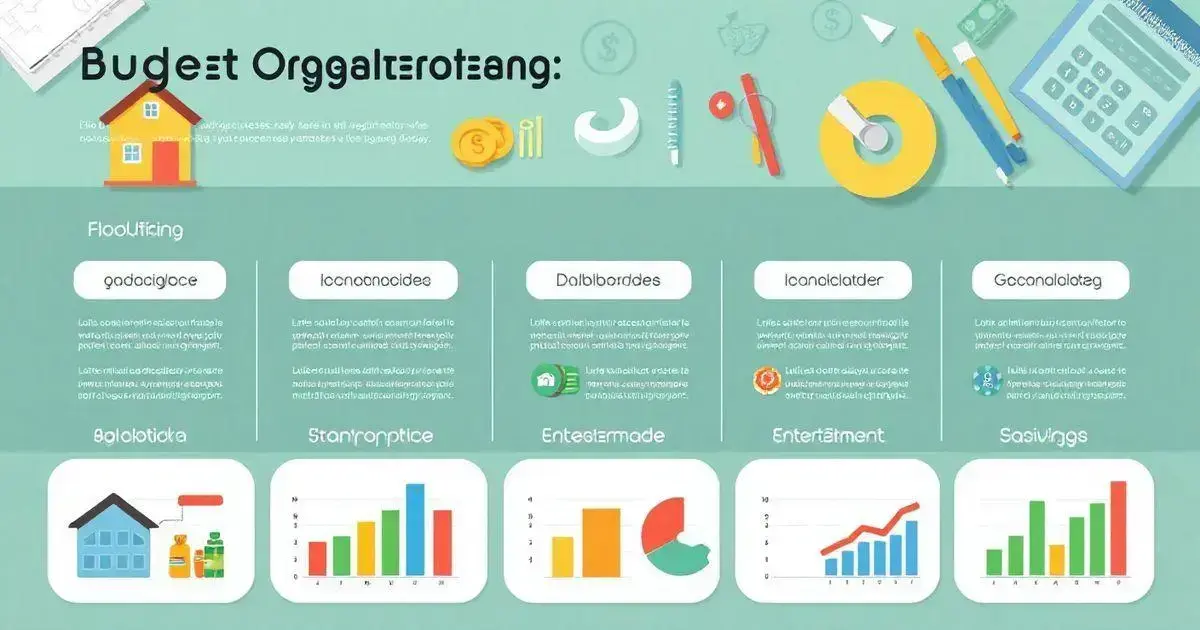Understanding the Basics of Budgeting
Understanding the basics of budgeting is essential for managing your finances effectively. A budget helps you track your income and expenses, which is crucial for achieving your financial goals. Learning how to create a monthly budget in Google Sheets can be a great first step in gaining control over your finances.
Start by listing all your sources of income, including salaries, side jobs, and any freelance work. Next, categorize your expenses into fixed and variable costs. Fixed costs are expenses that remain the same each month, like rent or mortgage payments, while variable costs can fluctuate, such as groceries or entertainment.
By knowing where your money goes, you can identify areas where you can cut back and save more. How to create a monthly budget in Google Sheets will help you organize this information and keep track effortlessly.
It’s important to set realistic spending limits in each category. This way, you’ll be more likely to stick to your budget. Additionally, reviewing your budget regularly can help you adjust and stay on track.
Tracking every dollar might seem tedious, but it’s rewarding when you see the changes in your financial situation over time. Remember, budgeting is not just about restriction; it’s about making informed choices and planning for a secure financial future.
Setting Up Your Google Sheets

Setting up your Google Sheets for budgeting is the first step to managing your finances. To begin, open a new spreadsheet and name it something like ‘Monthly Budget’. This will help you easily find it later. Learning how to create a monthly budget in Google Sheets will make this process smooth and efficient.
Next, create column headers to organize your data effectively. For instance, you should have columns for Date, Description, Category, Income, and Expenses.
Once you’ve set up these basic elements, you can begin entering your financial data. Using how to create a monthly budget in Google Sheets can help ensure everything is well-organized and accessible.
To automate your calculations, use simple formulas. For example, use the SUM function to total your income and expenses. This gives you a clear picture of your financial status. You can also create a summary section at the top of your sheet for a snapshot view of your budget. Lastly, don’t forget to regularly update your sheet to stay on top of your finances.
Inputting Your Income and Expenses
Inputting your income and expenses into Google Sheets is a vital part of budgeting. Start by creating a new row for each expense or income source. Be precise with entries to ensure accuracy. Include the date of each entry, a brief description, and the amount for clear tracking. Tracking your expenses accurately allows you to see where your money is going.
For income, specify whether it is salary, freelance work, or other types. This will help you understand your cash flow better. Ensure that every income source is included so that your budget reflects your true financial situation. Regularly entering this information will make your tracking consistent and reliable.
As you input data, consider creating a separate column for categories to group expenses such as food, housing, transportation, and entertainment. This categorization helps in analyzing spending patterns and making informed decisions later. Remember to double-check your entries to minimize errors, as even small mistakes can affect your overall budget.
Creating Categories for Your Budget

Creating categories for your budget is essential for managing your finances effectively. By categorizing your expenses, you can easily see where your money goes and identify areas for improvement. Learning how to create a monthly budget in Google Sheets with well-defined categories will streamline this process.
Start by determining key categories that fit your lifestyle. Common categories include housing, utilities, groceries, and entertainment. Once you have your categories, list them in your Google Sheets under a new column named Category. As you input your expenses, assign each one to the appropriate category. This will help you track specific spending habits and make informed budgeting choices.
You may also want to create subcategories for more detailed tracking. For example, under entertainment, you could have movies, dining out, and events.
This level of detail provides better insight into your spending patterns. By knowing how to create a monthly budget in Google Sheets with these subcategories, you’ll gain a clearer understanding of where you can cut back.
Remember to review your categories regularly. If you find that certain categories are consistently overspent, consider adjusting them. An effective budgeting system is flexible and can evolve with your changing financial needs.
Using Formulas for Calculations
Using formulas in Google Sheets can make your budgeting process more effective and efficient. Formulas allow you to automate calculations, helping you to quickly understand your financial situation. If you’re wondering how to create a monthly budget in Google Sheets, knowing how to implement formulas is a key step.
Start by learning basic formulas like SUM, AVERAGE, and IF. The SUM function is one of the most useful for budgeting. You can use it to add up all your expenses or income for a specific period. Simply type =SUM(B2:B10) in a cell, where B2 to B10 is the range of cells with the amounts you want to total.
The AVERAGE function helps you determine your average spending in each category. Type =AVERAGE(C2:C10) to find the average expense from that range. This gives you insight into whether you’re staying within your monthly limits.
The IF function allows you to create conditions in your budget. For example, you can set up a formula to highlight expenses that exceed a certain amount. Use =IF(D2>100, “Above Budget”, “Within Budget”) to flag any expenses over $100.
Lastly, don’t forget to use cell references wisely. Instead of typing numbers directly into formulas, reference the cells to allow for easy updates. This way, if your income or expenses change, the calculations will automatically update, keeping your budget accurate.
Tracking Your Monthly Spending
![]()
Tracking your monthly spending is crucial for effective budgeting. By knowing where your money goes, you can make informed decisions and avoid overspending.
Start by reviewing your transactions regularly. You can do this weekly or monthly, depending on your preference.
Using your Google Sheets budget, ensure that every expense is logged. Categorize each entry to help you see patterns in your spending. For instance, if you notice that you are spending too much on eating out, you can adjust your budget for the next month.
Visual tools can also help in tracking your spending. Consider creating charts or graphs in Google Sheets to visualize your monthly expenses. A simple pie chart can show you how much of your budget is spent on various categories.
Another helpful method is to set spending limits for each category. Once you hit your limit, it’s time to stop spending in that area. This system encourages discipline and helps prevent impulse purchases.
Finally, remember to adjust your tracking as needed. Life changes, and so do your expenses. Regularly update your spending categories and limits to reflect your current situation. By staying proactive, you will be better equipped to manage your finances effectively.
Adjusting Your Budget as Needed
Adjusting your budget as needed is an important part of financial management. Life is full of surprises, and your budget should reflect changes in your income or expenses. If you’re wondering how to create a monthly budget in Google Sheets, knowing how to make regular adjustments is key to maintaining control over your finances.
Start by reviewing your current budget monthly to see where adjustments may be necessary. Look for categories where you consistently overspend or underspend. If you frequently exceed your grocery budget, for example, consider increasing that specific category.
Another key aspect is to account for any new income sources or changes in existing ones. If you receive a raise or take on a new freelance job, update your income section to reflect this. This will give you a clearer picture of your financial situation.
Don’t forget to account for seasonal expenses as well. If you know your heating bills will rise in winter or that holiday spending will increase, adjust your budget ahead of time. This way, you can plan for these expenses without feeling overwhelmed.
Lastly, be flexible. Budgets are not set in stone and can change as your life changes. Regular adjustments will help you stick to your goals and maintain control over your finances. Embrace the idea that it’s okay to make changes; this is part of responsible budgeting.
Tips for Staying On Track

Staying on track with your budget is essential for achieving your financial goals. Here are some tips to help you stay focused. First, review your budget regularly. A weekly check can keep you aware of your spending and help you adjust any areas where you are overspending.
Next, set specific financial goals. Whether it’s saving for a vacation or paying off debt, having clear targets gives you motivation. You can even break these goals into smaller, achievable steps to keep yourself encouraged.
Utilize apps or tools that send notifications or reminders. These can prompt you to log your expenses and remind you of your budget limits. Adding these reminders helps maintain accountability.
Additionally, consider creating a visual tracker, like a chart or graph, in your Google Sheets. Visual representations of your progress can provide a motivational boost.
Lastly, be kind to yourself. Sometimes, overspending happens. Instead of feeling defeated, use it as a learning experience. Adjust your budget accordingly and move forward with your financial journey.
In Conclusion
Managing your budget effectively can lead you to financial success. By understanding the basics, creating categories, and using tools like Google Sheets, you can take control of your finances. If you’re wondering how to create a monthly budget in Google Sheets, the key lies in consistent tracking and updating.
Remember to input your income and expenses accurately and adjust your budget as needed to reflect your current situation. Tracking your monthly spending helps you stay accountable, while tips for staying on track keep your goals in sight.
With dedication and the right strategies, you can achieve your financial objectives and enjoy peace of mind.


